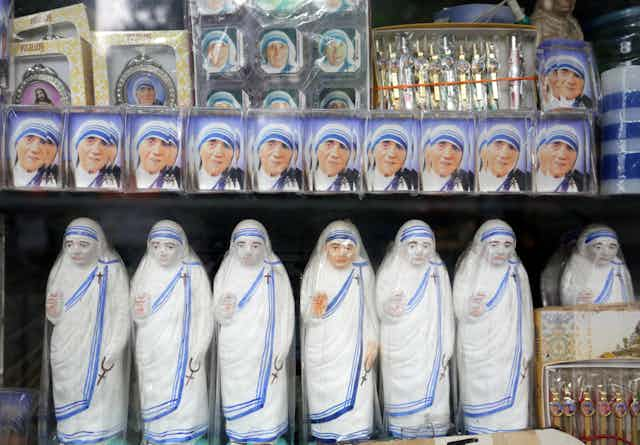The Catholic Church will formally make Mother Teresa of Calcutta a saint during a ceremony at the Vatican on September 4, a little under two decades since her death in 1997.
To her admirers, she should have been canonised even earlier. Few religious personalities were as successful as Mother Teresa in serving and promoting the Catholic faith worldwide in the second half of the 20th century, particularly after she was awarded the 1979 Nobel Prize for Peace. According to the BBC, by July 1999 the Vatican had already received a huge mailbag from people requesting her speedy sainthood.
Mother Teresa’s delayed canonisation has turned into a sensitive issue because of the saintly status she enjoyed in her lifetime, an issue I have looked at in my research. Mother Teresa was born Anjeza Gonxhe Bojaxhiu in Skopje, present-day Macedonia, to Albanian parents in 1910 and moved to Calcutta at the end of 1928 to join the Loreto order. As early as 1949, a reporter first used the word saint in relation to the nun, who had just left the Loreto order and was about to set up the Missionaries of Charity to help the poorest of the poor in the slums of Calcutta.
Her status as a media saint gained momentum in the West especially after a BBC interview in 1968. In an ensuing documentary about her life in Calcutta, the journalist Malcolm Muggeridge made the infamous claim that the camera had captured a halo around Mother Teresa – even though his cameraman tried to explain it was to do with the film used. Embarrassing as Muggeridge’s claim was even for the church, it stuck and she became known as the “saint of the gutters” with both Indian and world leaders paying tribute to her work. This portrayal reached a climax when her portrait was featured on the cover of Time magazine in 1975 with the caption “Messengers of Love and Hope – Living Saints”.
Quick start
So it is understandable why shortly after Mother Teresa’s death, her supporters were looking forward to her speedy beatification, the first step in a two-step process to sainthood, in which the Pope declares the candidate saint is in a state of bliss.
Mother Theresa’s supporters were hopeful that this would not take long, given her close friendship with Pope John Paul II. By then, he already had an impressive record in saint-making and had supported reforms that made the process simpler. The number of people beatified and canonised during his pontificate increased dramatically. While approximately 100 people were made saints by all of his 20th century predecessors, John Paul II canonised close to 500 individuals.
In order for a candidate to become a saint, two miracles are required – one for beatification and one for the final canonisation, when the person is declared a saint. The miracles should happen after the candidate saint has died, proving that they are in heaven and have the power of intercession – to put in a good word with God to help cure the sick on earth.
In Mother Teresa’s case, in 2001 an Indian woman called Monica Besra claimed that she had been cured of an abdominal tumour through Mother Teresa’s intercession in 1998, on the first anniversary of the nun’s death. The whole beatification process was then brought to conclusion in 2003, just over six years after Mother Teresa’s death. Only the beatification of John Paul II was completed in a shorter time (but only by a mere two weeks).

John Paul II was keen to wrap up Mother Teresa’s entire canonisation process as soon as possible because of his deteriorating health. But he was not able to complete what he had started and after his death in 2005, Mother Teresa’s canonisation no longer appeared a priority for the Vatican.
Wobbles on the way
There were also problems with some private writings by Mother Teresa which revealed the length and intensity of her doubt in the existence of God, more often referred to euphemistically as “spiritual darkness”. As my ongoing research has examined, John Paul II had been made aware of this in 1999, a few excerpts appeared in two articles penned by Mother Teresa’s friends in 2000 and 2001, and it was mentioned by the Archbishop of Calcutta, Henry D’Souza during a 2001 CNN interview. But a larger body of the nun’s controversial writings only became public in 2007 – four years after her beatification – in a book which made her path to sainthood more precarious.
Despite this, outside pressure on the Vatican continued from Mother Teresa’s supporters for her to be canonised. The delay in making Mother Teresa a saint also rekindled debates about the Holy See’s “double-standards” in recognising the contribution of nuns and the longer queue to sainthood that women apparently have to follow compared to men.
Even before his election to the papacy, Pope Francis had made it clear his huge respect for Mother Teresa’s work and legacy, something he reiterated during his 2014 visit to Albania.
In view of the hiccups between 1999 and 2003, the entire preparatory work for Mother Terea’s canonisation has been conducted in utmost secrecy. The second “miracle” required for her to be made into a saint was approved by Pope Francis in December 2015. This was despite the fact that the miracle had apparently taken place in Brazil seven years earlier in 2008, when a man was apparently healed from a bacterial infection in the brain after prayers were said for him to Mother Teresa.
So it has been a long road to sainthood for somebody many believed lived a saintly existence while on earth. Mother Teresa is a worthy saint – if only for her exemplary devotion to her calling and in spite of her lifelong gnawing spiritual darkness. This will ensure that she will still be remembered and inspire people of all faiths or none, when many saints will have been long relegated to obscurity.

